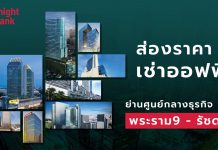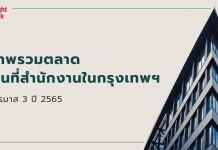Mr. Marcus Burtenshaw, Executive Director and Head of Occupier Services and Commercial Agency (OSCA), Knight Frank Thailand, said, “Over the past few years, Environmental Social & Governance (ESG) considerations have become increasingly incorporated into policies, corporate governance frameworks and investment decisions of major financial institutions. But in the wake of pandemic, ESG concerns have really entered centre stage as leading corporates around the world pledge to deepen focus on ESG during the COVID-19 recovery period, and, for a growing number of multinationals, ESG related KPIs are now even linked directly to executive pay. According to the UN, the built environment is responsible for 30% of greenhouse gases and consumes about 36% of the world’s energy. To meet the Paris Agreement by 2050 all buildings must be carbon neutral. Yet today, not even 1% of buildings meet that standard.
In Thailand, ESG related issues have long been set aside, but we believe that times are changing. This year, the Stock Exchange of Commission of Thailand has introduced the One Report requirement, in which the topic of CSR has been replaced by Business Development for Sustainability. This has elevated the level of sustainability disclosure as firms must disclose strategies, goals and sustainability targets, as well as a responsibility to share value chain issues and their own environmental impact. In the logistics property sector here in Thailand, there are now some excellent examples of eco-friendly warehousing, with solar panels on rooftops, solar carparks, LED lighting with motion sensors, and rainwater harvesting.
Looking ahead, I expect that these features will become par for the course, rather than merely exceptional examples. The challenges ahead for developers will not be those related to management, or of designing buildings to be even more energy efficient. It will be with upgrading and decarbonising their existing inventories to ensure that they don’t fade into obsolescence as sustainability matures from being a ‘nice to have requirement,’ to become a mandatory selection criterion.”

Economic Overview
In Q2 2021, the Thai economy expanded by 7.5% Y-o-Y, improving from a 2.6% contraction recorded in Q1. For the entire first half of 2021, the GDP of Thailand expanded by 2%.
Previous Article for Logistics Property Market 2020
Both private consumption and government consumption expenditure declined, falling by 2.1% and 1.6% respectively. Following the 3rd wave of COVID-19 and outbreaks of the delta strain, consumer confidence fell considerably in Q2. Total investment increased by 7.6%, thanks to improvements in both private and public investment, which expanded by 5.9% and 12.1% respectively. On a positive note, exports of goods and services increased by 19%. This is because export volume increased by 15.5% and export prices increased by 3.1%. Meanwhile, imports grew by 23.8%. On the production side, the transportation and storage sector contracted by 6.6% in H1. However, this is an improvement from the 21.6% drop in H2 2020.
The growth in H1 largely reflects a rebound from last year’s sharp decline. Despite improvements to economic conditions recorded in this half, the outlook for the economy is poor. For the 3rd time, Thailand’s economic planning agency revised the full year growth forecast downward. It now projects the Thai economy to grow by 0.7% to 1.2%, down from the 1.5% to 2.5% growth predicted earlier. The economy’s trajectory will be highly contingent on how the country contains its biggest COVID-19 outbreak amid a slow vaccination rollout.

Supply
Total supply of ready-built warehouses in Thailand increased by 2.5% Y-o-Y to reach 4.65 million sq m in H1 2021. New projects only accounted for 12% of total supply added in this half, indicating that developers mostly expanded within existing projects. Logistics property players remain committed to maintaining and improving current stock performance over launching new projects unless they received clear and substantial interest from tenants beforehand. As such, there is limited speculative building in the market.

Supply Distribution
The new supply added in H1 was highly concentrated within the Bangkok Metropolitan Region, which experienced a 4% Y-o-Y supply growth to reach 2.2 million sq m. As a result, the region now has a 46% market share. Developers have responded to occupier demand for facilities near the capital city that can facilitate a faster product delivery time to end users. Supply in the Eastern Seaboard, which accounts for 37% of total supply, expanded at a relatively limited pace, growing by 0.8% to reach 1.7 million sq m. Meanwhile, total supply in the central region increased by 2.4% Y-o-Y.

Demand
Leasing activity dropped as net absorption fell from close to 50,000 sq m in H2 2020 to around 38,000 sq m this half. Nevertheless, a positive net absorption indicates that market demand for ready-built warehouses remains relatively robust. The e-commerce boom and greater adoption of technology propelled growth for online retailers and distribution firms, which in turn drove take up of logistics space as they expanded capacity and raced to secure locations that generate competitive advantages from a fulfilment standpoint. As a result, total occupied space increased by 2.3% Y-o-Y to 3.86 million sq m
Nonetheless, the significant windfall from the accelerated shift to online was reaped by the built-to-suit warehouse developers. Combined, they have delivered more than 100,000 sq m of BTS space in H1 2021. The intensifying the competition for market share in the e-commerce and 3PL spaces has triggered an increased need for specialized automated solutions to maximize efficiency and profitability. As this will require greater differentiation amongst logistics properties, occupiers have turned to developers for more customer-centric solutions that cannot be met with most standard ready-built spaces available today.


As net absorption lagged supply growth slightly, the market occupancy rate dropped by 0.6% points. H-o-H to 83%. All sub-markets tracked experienced some level of decline on a quarterly basis. On an annual basis, the Bangkok metropolitan region was the only area in which the market occupancy rate rose, increasing by 1% to 90%, indicating that available supply in the area remains somewhat limited. In comparison, the occupancy rate in the Eastern Seaboard and Central regions stands at 76% and 79% respectively.

Rental Rates
The average asking rent for ready-built warehouses in Thailand remained at 158 baht per sq m per month. Some landlords have granted rental rebates to some tenants to help alleviate financial pressures, but this is done on a case-by-case basis.
Split by sub-market, the asking rent for warehouse properties in the Bangkok metropolitan and Eastern Seaboard have almost converged at around 160 to 161 baht. The asking rent in the Bangkok metro has steadily gained on the rate in the Eastern Seaboard over the past few years and may soon exceed it as the capital city continues to grow in importance for occupiers focused on last-mile logistics. The Central region remains the cheapest sub-market, with an average asking rent of 146 baht.

Although there was a noticeable difference in average asking rents, the rental spread was quite similar across the various regions. The most expensive warehouses commanded up to twice as much as their cheapest counterparts, leading to a wide rental spread of 80 baht to 100 baht. It indicates that in all 3 regions, there are warehouses of various qualities ranging from older, competitively priced properties to newer, ‘premium’ warehouses catering to different segments of tenants. The implementation of automation and other technologies such as warehouse management systems is still limited in Thailand in comparison to developed markets. However, greater market adoption of technology in warehousing solutions could result in an even wider spread for warehouse prices going forward.

Review & Outlook
Underpinned by the e-commerce boom, the logistics property market continued to expand despite the sustained impact of COVID-19 on economies and supply chains globally. While most of the demand for warehousing space was fulfilled by Built-to-Suit logistics properties, ready-built warehouses also benefited as indicated by the positive albeit muted net absorption recorded in H1 2021.
As predicted, the e-commerce and 3PL sectors drove the bulk of leasing activity in this half. Both sectors will continue to grow in market share of logistics space occupied as the accelerated growth trajectory that the pandemic provided both sectors is expected to sustain. Most consumers that shopped online because of lockdown measures will continue to do so. Meanwhile, existing brick-and-mortar stores will also look become omni-channel to push sales or risk falling behind. As businesses increasingly outsource their warehousing requirements to specialists in the field, 3PL providers will stand to benefit further.
Technological adoption in the Thai logistics property market is low but has high potential for growth. We are already observing an increasing number of Built-to-Suit facilities that have integrated technology to drive value, such as a 21,000 sq m fully automated distribution centre with robot-based storage solution successfully handed over to F&N by Frasers Property. We expect that ready-built warehouses will incorporate more technology to enhance their competitiveness going forward as well. Leading the way will be cold chain warehousing, as growth in organized food delivery and the pharmaceutical sector will drive demand for temperature-controlled solutions to store a range of goods from fruits, vegetables, dairy, fish and meat to vaccines and medication. Recently, state-owned mail carrier Thailand Post has formed a joint venture with e-commerce logistics startup Flash Express and JWD InfoLogistics to launch cold chain express delivery under the Fuze Post brand, while Kerry Express has also announced plans to launch their own service in the H2.
As we mentioned in our last report, the area of will most likely be the Bangkok metropolitan region due to Bangkok’s status as the economic engine of Thailand and the growing importance of last-mile logistics. Logistics properties surrounding the capital city enable retailers and logistics operators to be closer to their customer base, promoting short turn around delivery times, and that means sales. The resiliency and growth potential of logistics property in the region has attracted attention from both domestic and international players. Residential developers such as Sansiri and Origin Property have formed joint ventures with logistics solutions providers with plans to develop over 200,000 sq m of space over the next year.
The heightened competition for land to develop logistics properties near Bangkok may present supply-side challenges. For logistics facilities to locate within or close to urban centres, they must compete with other land uses and utilize land more intensively. According to REIC, the price index of vacant land in greater Bangkok increased by an average of 18% annually from 2016 to 2020. The high cost of land will put pressure on distribution networks to implement greater efficiencies and may give rise to new fulfilment models. In other advanced markets, we have seen the emergence of Micro-Fulfilment Centres (MFC) – small-scale or compact warehouse facilities usually located in accessible urban locations close to the end consumer – designed to fulfil online orders, click-and-collect and home delivery using automation and vertical shelving. With greater differentiation via technology in the ready-built warehouse market and further development in urban spaces, we could see asking rents for logistics properties in Thailand rise to compensate for increasing replacement costs.



















